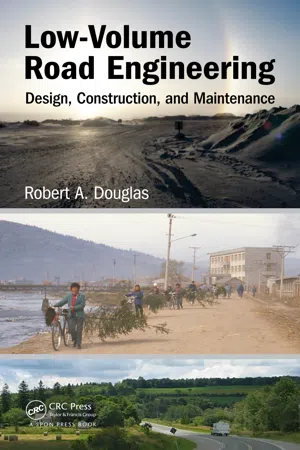
- 326 pages
- English
- PDF
- Available on iOS & Android
About This Book
"Everything that sustains us – grown, mined, or drilled – begins its journey to us on a low-volume road (Long)." Defined as roads with traffic volumes of no more than 400 vehicles per day, they have enormous impacts on economies, communication, and social interaction. Low-volume roads comprise, at one end of the spectrum, farm-to-market roads, roads in developing countries, northern roads, roads on aboriginal lands and parklands; and at the other end of the spectrum, heavy haul roads for mining, oil and gas, oil sands extraction, and forestry.
Low-Volume Road Engineering: Design, Construction, and Maintenance
gives an international perspective to the engineering design of low-volume roads and their construction and maintenance. It is a single reference drawing from the dispersed literature. It lays out the basic principles of each topic, from road location and geometric design, pavement design, slope stability and erosion control, through construction to maintenance, then refers the reader to more comprehensive treatment elsewhere. Wherever possible, comparisons are made between the standard specifications and practices existing in the US, Canada, the UK, South Africa, Australia and New Zealand.
Topics covered include the following:
- Road classification, location, and geometric design
- Pavement concepts, materials, and thickness design
- Drainage, erosion and sediment control, and watercrossings
- Slope stability
- Geosynthetics
- Road construction, maintenance, and maintenance management
Low-Volume Road Engineering: Design, Construction, and Maintenance i
s a valuable reference for engineers, planners, designers and project managers in consulting firms, contracting firms and NGOs. It also is an essential reference in support of university courses on transportation engineering and planning, and on mining, oil and gas, and forestry infrastructure.
Frequently asked questions
Information
Table of contents
- Front Cover
- Contents
- Preface
- Acknowledgments
- Author
- About the book
- Part I: Introduction
- Chapter 1: Introduction to low-volume roads
- Part II: Road design
- Chapter 2: Road location
- Chapter 3: Road classification
- Chapter 4: Geometric design
- Chapter 5: Pavement concepts
- Chapter 6: Pavement materials
- Chapter 7: Pavement design
- Chapter 8: Drainage
- Chapter 9: Soil erosion and sedimentation control
- Chapter 10: Watercourse crossings
- Chapter 11: Slope stability
- Chapter 12: Geosynthetics
- Part III: Road construction and maintenance
- Chapter 13: Road construction
- Chapter 14: Road maintenance
- Chapter 15: Pavement maintenance and rehabilitation management
- Index
- Back Cover